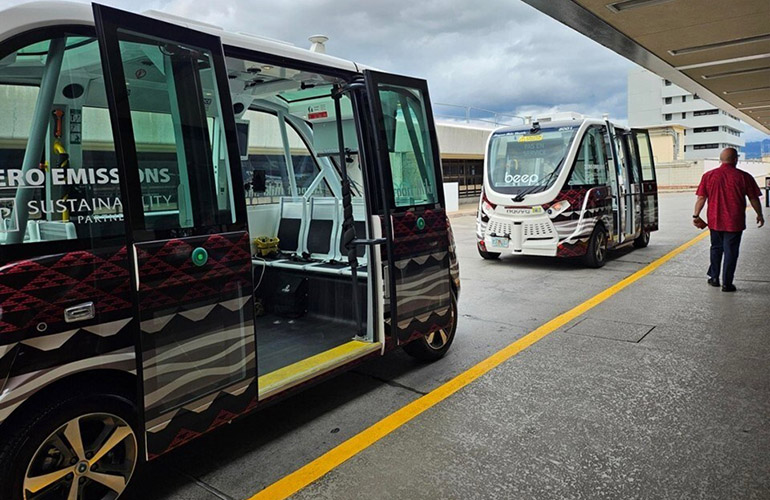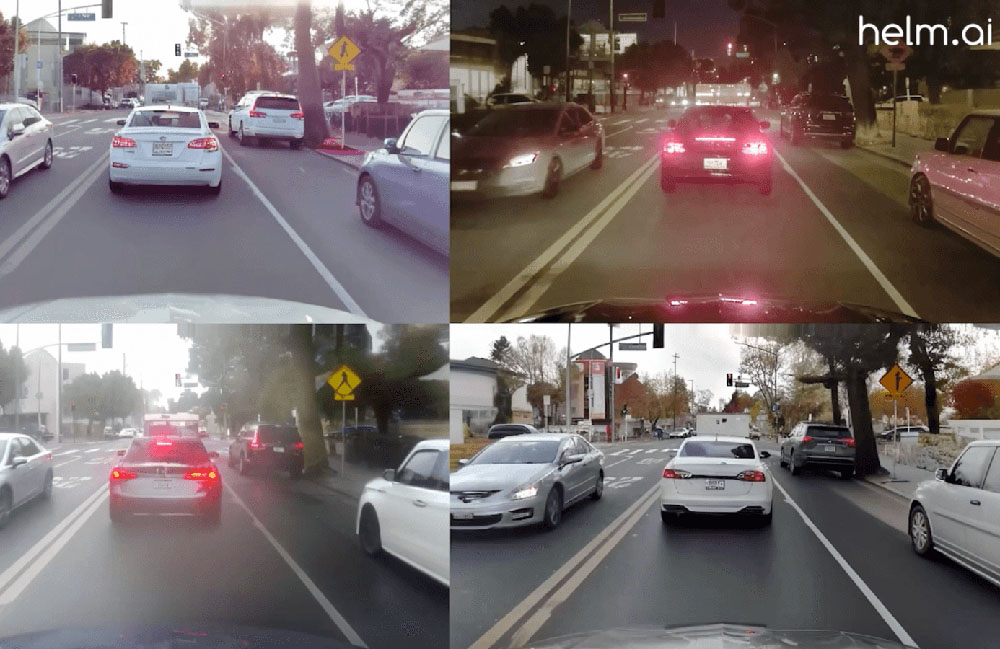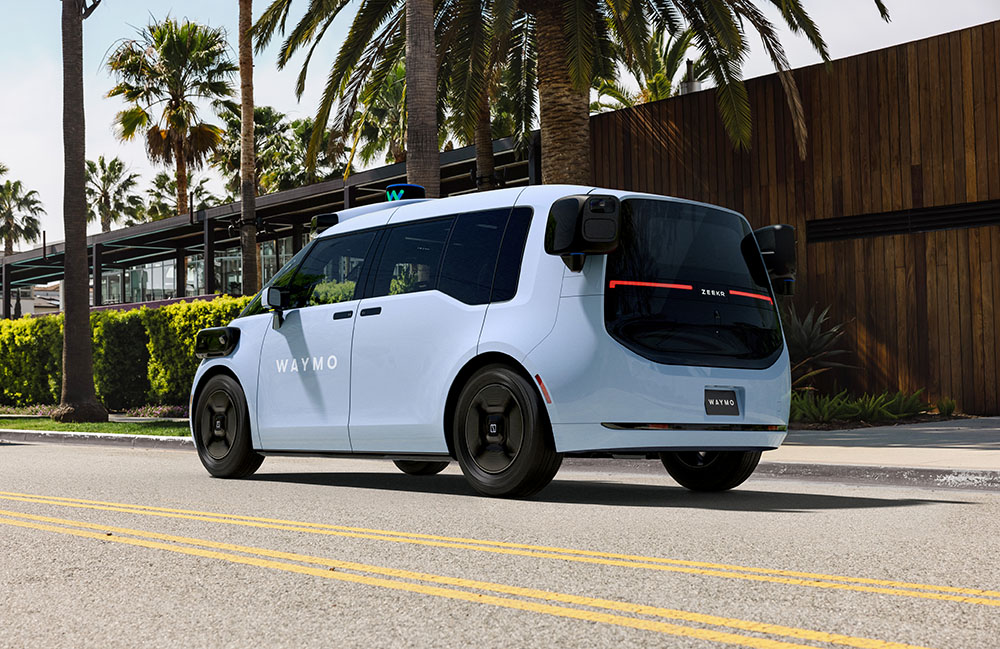
Wiki Wiki shuttles await passenger riders at the Daniel K. Inouye International Airport (HNL) in Honolulu. Source: Beep
As millions of people in the Northern Hemisphere begin summer vacations, some of them will board autonomous vehicles for part of their journeys. Last month, Beep Inc. announced that it is working with the Hawai’i Department of Transportation, or HDOT, and Sustainability Partners to launch an 18-month self-driving shuttle pilot at Daniel K. Inouye International Airport, formerly HNL.
“Through our partnership with Sustainability Partners, we’re honored that HDOT and HNL have placed their trust in our experience, leadership and differentiated approach of safe and integrated autonomous mobility with the launch of the Miki shuttle pilot service,” stated Joe Moye, CEO of Beep, at the time. “Our fleet of turnkey shared and electric autonomous shuttles prioritizes safety and sustainability while enhancing the airport travel experience for passengers.”
Founded in 2018, Beep said it delivers software and services for next-generation autonomous, shared-mobility systems. The Orlando, Fla.-based company plans, deploys, and manages autonomous shuttles for private and public communities. It also claimed that it continually improves safety and operating capabilities with data from its deployments.
Eduardo Rosa, senior vice president of operations at Beep, answered the following questions about the Honolulu deployment, which the company claimed is the first of its kind:
Autonomous shuttles face crowded airport environs
What are some of the current transport challenges at airports, and specifically at the Daniel K. Inouye International Airport?
Rosa: Between a skyrocketing number of air travelers, traditional transportation networks and staffing issues, many airports around the country are facing significant challenges addressing their transportation needs.
While the Daniel K. Inouye International Airport shares many common transport challenges with other major airports, its unique location and the high volume of tourist traffic presents specific issues that require ongoing attention and improvement.
The Hawaii Department of Transportation, which operates HNL and 14 other airports statewide, is addressing these challenges through an airports modernization program that includes infrastructure upgrades, improved traffic management systems, and enhancements to existing transport links. This includes initiatives such as the pilot program with Beep to see if autonomous shuttles can be incorporated into the airport’s passenger-shuttle operations.
How does the Miki shuttle deal with obstacles such as luggage carts, manual shuttles, and pedestrians?
Rosa: Like all of Beep’s autonomous shared-mobility solutions, the Miki — the Hawaiian word for “agile” — shuttles are equipped with autonomous software and hardware that allow the vehicles to safely navigate any obstacles and operate alongside human-driven vehicles. These technologies, along with an onboard attendant, allow the shuttles to be operated safely in airport and other congested environments like campuses, communities, and public transit.
The Miki shuttles operate as secondary support vehicles to the airport’s existing Wiki Wiki — the Hawaiian word for “fast” — shuttle buses. The vehicles operate along dedicated routes in the airport’s restricted area, where pedestrians, luggage carts and other obstacles do not impede mobility.
Beep leverages its leadership in having run the nation’s largest and most tenured autonomous shuttle service deployments to date—from Hawaii, California, and North Carolina to Florida and more from coast to coast. [It] is entrusted by local governments and transit authorities nationwide.
Our deployments have shuttled tens of thousands of people safely and are allowing us to actively lead the charge in evolving the technology and operations to navigate through complicated, real-world environments. It’s a constant evolution.
How much integration is necessary between the Miki and Wiki Wiki shuttles?
Rosa: With the ability to carry 11 passengers including an attendant, the Miki shuttles are operating on the same routes as the Wiki Wiki shuttles and are easily capable of working alongside and augmenting human-driven routes. In many of Beep’s deployments, shuttles operate safely alongside other drivers and municipal vehicles.
The Miki and Wiki Wiki shuttles transport passengers between Terminals 1 and 2 between 7:00 a.m. and 10:00 p.m. daily.
Beep engaged the Wiki Wiki service early on in the deployment process to ensure seamless integration and coordinated operations of augmented transportation. Beep always maintains continuous radio communications with the buses at all times through our Command Center, allowing for real-time updates and immediate response to any issues, thereby enhancing safety and efficiency.
Most of Beep’s shuttle deployments are designed to integrate into and enhance existing transport systems – reflected strongly by this project being led by the Hawai’i Department of Transportation and facilitated by Sustainability Partners.

Beep is working with the Jacksonville Transportation Authority in Florida on the Autonomous Innovation Center. Source: Beep
Beep dedicates staffers to Mika shuttle pilot
Are the shuttles fully autonomous — is there a teleoperation or manual option?
Rosa: The Miki shuttles operate autonomously along a pre-programmed route with an onboard attendant who, at any time, can take control of the shuttle if needed. These staff members are there to educate passengers about autonomous vehicles, as well as serve as an extra set of eyes for safety – in line with our work with NHTSA [National Highway Traffic Safety Administration].
Additionally, technicians in the Beep Command Center at our headquarters in Orlando’s Lake Nona are able to monitor shuttles remotely and can alert the attendant if there is a need for them to take manual control of the vehicle.
Are there dedicated staffers from Beep or HNL onsite during this pilot?
Rosa: Yes, in addition to the attendants who are on board the shuttles while they are in operation. All Beep service deployments are integrated into the communities where we operate with a mobility-as-a-service approach that’s clearly differentiated from other forms of AV implementation. This means everything from education, first responder training to other forms of onsite support.

Beep has launched the AutonomOS service management platform for rapid deployment and fleet visibility. Source: Beep
Sustainability a goal for autonomous shuttle developers
Is Sustainability Partners providing temporary charging infrastructure? How would that work at scale? Are the Wiki Wiki shuttles electric?
Rosa: The Wiki Wiki buses, HNL’s traditional transportation system, run on gasoline, but the Miki shuttles are all electric. The Hawai’i Department of Transportation, as part of its ongoing sustainability goals, is working to transition its fleet to electric vehicles, and the Miki shuttles are helping them work toward those goals.
Sustainability Partners is helping to advance the state’s electrification mission by facilitating the development of its electric vehicle infrastructure. The Beep shuttles only require a 220v plug to use their chargers, so temporary charging infrastructure is not required. The HNL Airport has ordered 18 electric transit buses as part of its efforts to transition its vehicle fleet to electric vehicles.
What are HDOT and the airport looking for in this pilot? What are their metrics or goals?
Rosa: HDOT and its partners are using the pilot project to evaluate new ways to increase the overall efficiency and augmentation of intra-airport transportation services. This pilot project is also helping HDOT continue testing the viability of electrified mobility as a clean, affordable option to connect passengers and staff to terminals and services.
Enhancing roadway safety is always a common goal between Beep and our partners, and is at the center of everything we do as a company—it is the focal point of planning, deployment and management of our mobility services and a critical component in our partnerships and education.
Beep builds on nationwide experience
How is this project different from Beep’s other deployments across the U.S., and have any of those led to full deployments?
Rosa: This project is a very exciting first use of Beep shuttles in an airport environment, the natural and ideal setting for shared, autonomous mobility systems.
It’s also very similar to many of our other projects spanning across the U.S. Beep has been testing and deploying autonomous shuttles in diverse environments for more than five years. This has brought us unmatched experience in the industry and provides us with the data, insights, and learnings needed to continue to safely advance the use of our shuttle systems in autonomous mobility networks everywhere.
Our leadership in testing and operating autonomous shuttle networks is demonstrated by the operation of the largest and longest tenured autonomous shuttle deployment in the U.S., with five routes serving Lake Nona, Fla.’s medical campus, residential community, business park and entertainment district in the master-planned, 17-sq.-mi. community.
We have also been awarded the nation’s largest public-sector contract for the deployment of autonomous shuttles by the Jacksonville Transportation Authority in Jacksonville, Fla. Beep also operated the first and only federally procured autonomous shuttle deployment serving public passengers at Yellowstone National Park, alongside additional deployments in Arizona, Florida, North Carolina, and Georgia.
We currently have several full deployments in planned developments, college campuses, retail hubs, municipalities and more. These first-mile, last-mile mobility solutions are providing valuable transportation options for passengers, while helping to reduce traffic and congestion where they are operating.

 6 months ago
94
6 months ago
94








 English (US) ·
English (US) ·